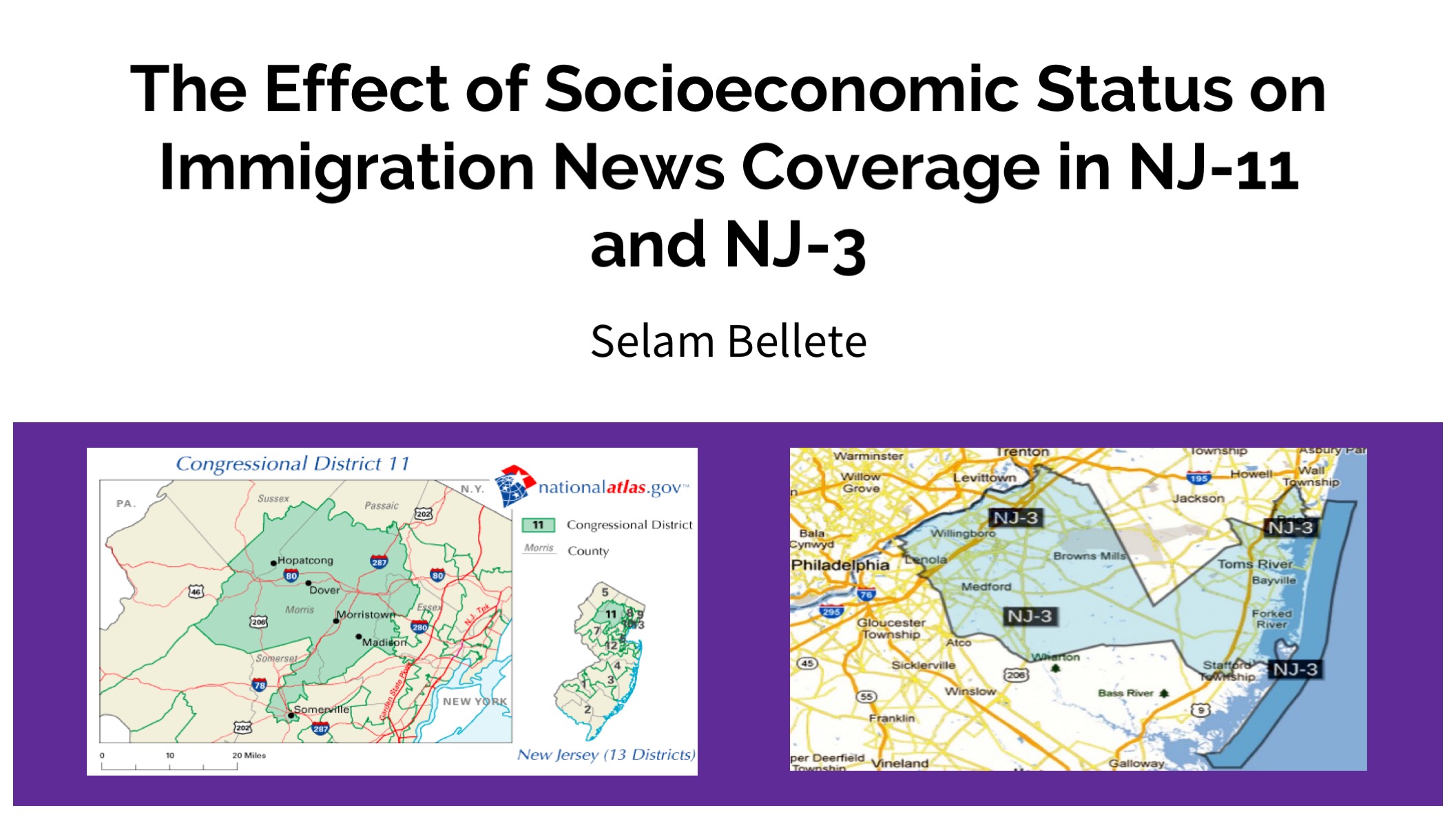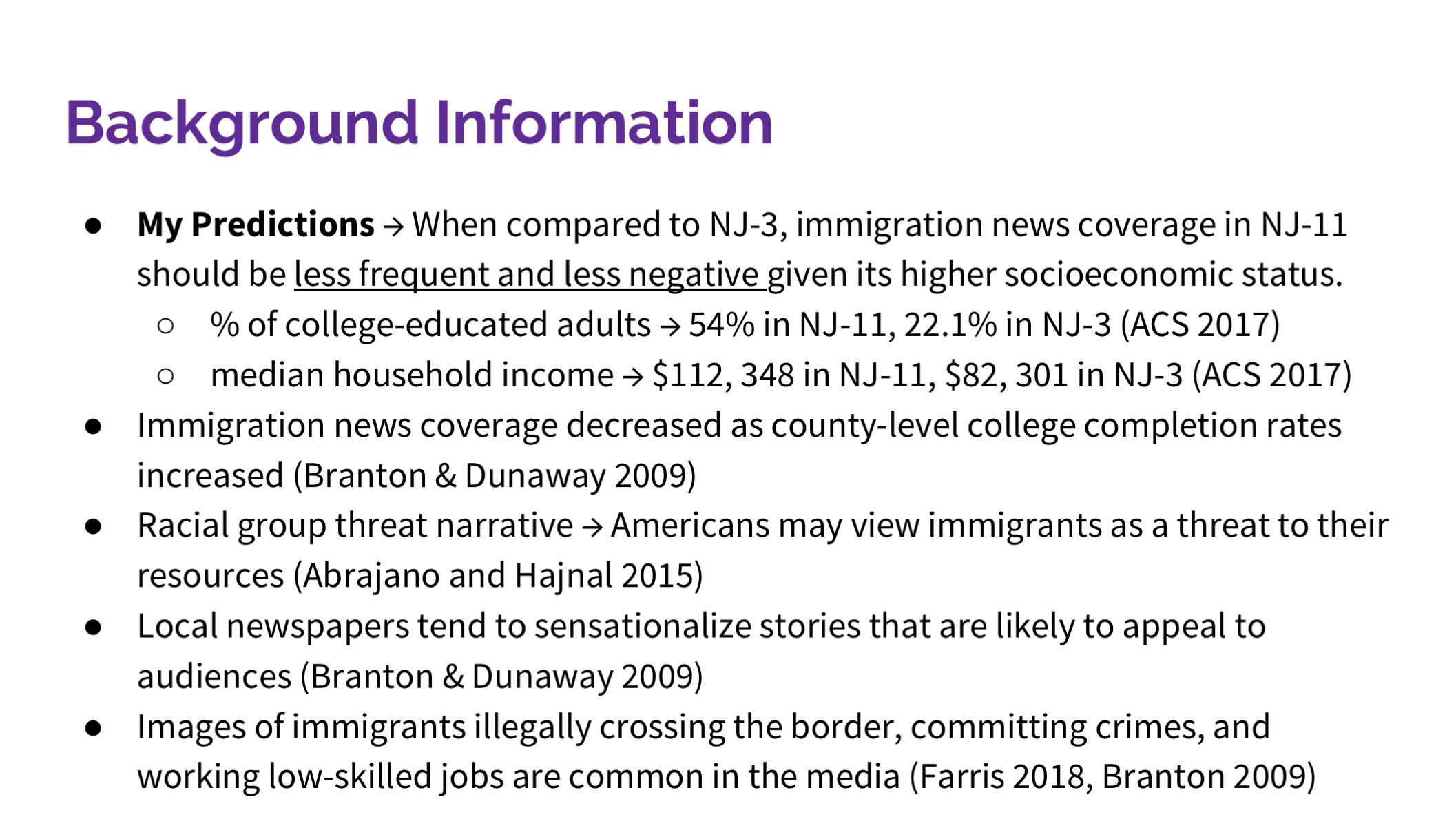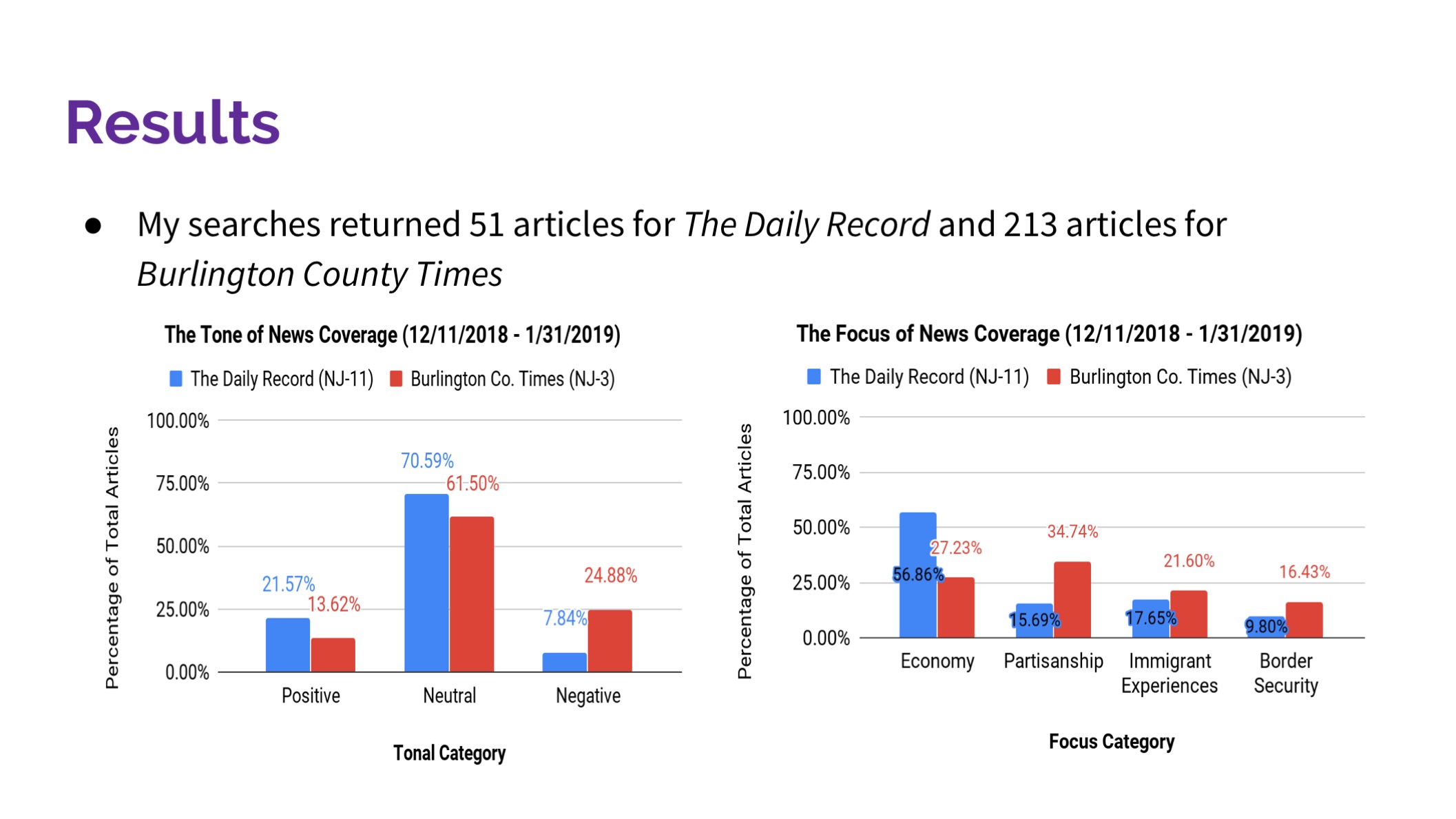

For this assignment, I measured socioeconomic status in terms of the district’s median household income and the percentage of adults over age 25 with a bachelor’s degree. My first hypothesis is that immigration news coverage in NJ-11 (a district with a high median household income and % college-educated) should not be as frequent as coverage in NJ-3 (a district with a lower median household income and % college educated). Branton and Dunaway’s study found that in California counties with a greater proportion of college-educated adults, news stories about immigration were less common. Since both California and NJ rank in the top 4 for states with the highest proportions of immigrants, I believe their prediction should hold true for NJ as well. My second hypothesis is that immigration news coverage in NJ-11 should be more positive/neutral than in NJ-3. Abrajano and Hajnal state that white Americans living near large populations of immigrants may feel that they are competing with them for jobs or other economic privileges, but this perceived threat is less likely to be salient for the citizens of NJ-11 since they are already well-off. Negative coverage of immigrants should resonate more with the less affluent citizens of NJ-3, which should give local media a greater profit incentive to exaggerate it (as Branton explains, local media has a tendency to emphasize issues that their constituents already find relevant). Stories depicting immigrants as unauthorized and criminal are already common in national media, so it is only natural that these stories should be more pronounced in NJ-3 news when compared to NJ-11.

I conducted searches using the key terms “immigrant”, “immigration”, “border”, “wall”, “undocumented”, “shutdown”, and “security” for a local county newspaper from each district. The Daily Record serves Morris County in Northern NJ, which is in District 11. The Burlington County Times serves District 3. I chose District 3 because it has a similar population of Latino people when compared to NJ-11, and this factor could indirectly influence news coverage: Abrajano and Hajnal find that white Americans living in areas with growing Latino populations have more negative attitudes towards immigration, which could cause local news to portray immigration more negatively.
If the articles’ coverage condemned the mistreatment of immigrants, mentioned their contributions to the US, or advocated for reforming laws in a way that helped them and any hardships they faced, I classified them as positive. If articles characterized immigrants as being dangerous, criminals, or a problem for American society I classified them as negative. Articles that did not discuss immigrants at all or whose coverage had aspects of both the “positive” and “negative” categories were classified as neutral. “Economy”, which is my first focus category, referred to articles that discussed the economic impacts of the shutdown on government workers. Articles discussing politicians’ responses to the government shutdown went into the “Partisanship” category. The “Immigrant Experience” category was for articles that discussed the lives of immigrants from all ethnicities and their physical migration into the country. Lastly, the “Border Security” category was for articles mentioning the construction of the wall, Border Patrol, and the views politicians and citizens had towards it. In order to determine the focus and tone of an article, I examined the diction in the title and quickly skimmed it to see how well the content aligned with the title.

To analyze the results of my coding, I created two bar graphs displaying the proportions of each category for focus and tone. The majority of both newspapers’ coverage made neutral statements about immigrants. 70.59% of The Daily Record’s 51 articles published within the given time period were classified as neutral, and 61.5% of the Burlington County Times (BCT) 213 articles were neutral. The BCT’s proportion of negative articles was 17.4 percentage points higher than The Daily Record, and this margin was nearly double the difference in the proportion of positive coverage for between the 2 papers (7.95%). The BCT’s proportion of negative coverage was only 11.26 percentage points higher than its proportion of positive coverage for the BCT, but for The Daily Record positive coverage was nearly 3 times more common than negative coverage. This indicates that for the BCT, negative coverage was more salient since it had less positive coverage to counteract it. The total proportion of BCT articles in the categories of “Immigrant Issues” and “Border Security” is 38.03%, but for The Daily Record this same proportion is 27.45%. For the BCT coverage is split fairly evenly across my four focus areas, and for The Daily Record news coverage is heavily concentrated in the “Economy” category.

Overall, the frequency of immigration stories in NJ-11 was lower than in NJ-3. My focus categories of “Immigrant Issues” and “Border Security” are the ones that primarily focus on immigration (“Economy” and “Partisanship” articles tended to be about the shutdown), and a lower percentage of articles from The Daily Record fell into this category when compared to the Burlington County Times (BCT). Since families in NJ-11 are more likely to be affluent, they are less likely to be worried about their economic status in relation to immigrants. This also explains why there was a high concentration of “Economy” articles for The Daily Record – these articles described the economic impacts of the shutdown on citizens without referencing immigrants. This economic threat narrative is driven by the idea that they are taking away low-skilled jobs from citizens, but in NJ-11 a high proportion of residents work in the pharmaceutical industry or business jobs in New York.
My second hypothesis was also supported, since the BCT had a lower percentage of neutral / positive articles and a higher percentage of negative articles. These results are consistent with Abrajano and Hajnal’s observation that less educated people are more hostile towards minorities. Since this tends to be the case, local newspapers would produce more negative articles in an attempt to appeal to them. One way this occurs is through a “crime news script”, or publicizing a disproportionate amount of nonwhite and immigrant criminal stories. For example, the BCT reported on two stories of undocumented immigrants killing citizens that The Daily Record did not report on at all.
I did not run a statistical test on my proportions, so I cannot be absolutely sure that the differences in proportions for focus and tone between the two newspapers / districts are significant. I believe the large difference between the number of articles for each paper affected this significance, since the BCT appeared to produce a greater volume of content in general when compared to The Daily Record. Since my coding method relied on my own judgment of the articles’ implications, there is a chance that it may not be 100% reproducible.